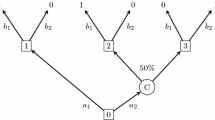Abstract
Richard Bradley’s Bayesian model of preference kinematics is compared with Sven Ove Hansson’s AGM-style model of preference revision. Both seek to model the revision of preference orders as a consequence of retaining consistency when some preferences change. Both models are often interpreted normatively, as giving advice on how an agent should revise her preferences. I raise four criticisms of the Bayesian model: it is unrealistic; it neglects an important change mechanism; it disregards endogenous information relevant to preference change, in particular about similarity and incompleteness; and its representational framework, when expanded with similarity comparisons, may give misleading advice. These criticisms are based on a principle of conservatism, and on two proposals of similarity metrics for the Bayesian model. The performance of the Bayesian model, with and without the similarity metrics, is then tested in three different cases of preference change, and compared to the performance of the AGM model.
Similar content being viewed by others
References
Bradley R. (2007) The kinematics of belief and desire. Synthese 156: 513–535
Bradley R. (2009a) Becker’s thesis and three models of preference change. Politics, Philosophy and Economics 8(2): 223–242
Bradley R. (2009b) Preference kinematics. In: Grüne-Yanoff T., Hansson S.-O. (eds) Modelling preference change. Approaches from philosophy economics and psychology. Springer, Theory and Decision Library, New York, NY, pp 221–242
Bradley R. (2009c) Revising incomplete attitudes. Synthese 171: 235–256
Gärdenfors P. (1988) Knowledge in Flux. Modeling the dynamics of epistemic states. MIT Press, Cambridge, MA
Grüne-Yanoff T., Hansson S.-O. (2009) Preference change. An introduction. In: Grüne-Yanoff T., Hansson S.-O. (eds) Modelling preference change. Approaches from Philosophy economics and psychology. Springer, Theory and Decision Library, New York, NY, pp 1–27
Hansson S.-O. (1995) Changes in preferences. Theory and Decision 38: 1–28
Hansson S.-O. (2001) The structure of values and norms. Cambridge University Press, Cambridge, MA
Jeffrey R. C. (1983) The logic of decision. University of Chicago Press, Chicago, IL
McCain K. (2008) The virtues of epistemic conservatism. Synthese 164: 185–200
Author information
Authors and Affiliations
Corresponding author
Rights and permissions
About this article
Cite this article
Grüne-Yanoff, T. Preference change and conservatism: comparing the Bayesian and the AGM models of preference revision. Synthese 190, 2623–2641 (2013). https://doi.org/10.1007/s11229-010-9863-7
Received:
Accepted:
Published:
Issue Date:
DOI: https://doi.org/10.1007/s11229-010-9863-7




